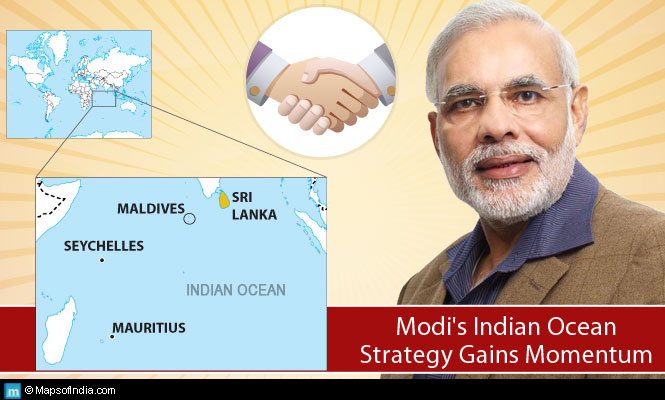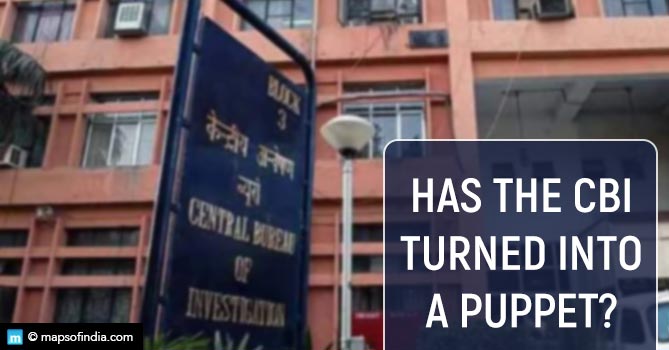 In September 2014, when Chinese President Xi Jinping landed in India for a three-day visit he had already visited Maldives and Sri Lanka – both strategically sensitive nations in the Indian Ocean region. From Male and Colombo, he had secured cooperation for his country’s much vaunted maritime silk route plan. He had also announced Beijing’s plans to intensify defence and maritime engagement with Maldives and Sri Lanka. Such moves were looked upon by India with concern.
In September 2014, when Chinese President Xi Jinping landed in India for a three-day visit he had already visited Maldives and Sri Lanka – both strategically sensitive nations in the Indian Ocean region. From Male and Colombo, he had secured cooperation for his country’s much vaunted maritime silk route plan. He had also announced Beijing’s plans to intensify defence and maritime engagement with Maldives and Sri Lanka. Such moves were looked upon by India with concern.
However, nearly seven months after the Chinese President’s visit to this part of the subcontinent, Prime Minister Narendra Modi is undertaking visits to Sri Lanka, Maldives, Mauritius and Seychelles from the second week of March. Ostensibly, this move aims at strengthening New Delhi’s diplomatic and strategic engagement with Indian Ocean countries, but in reality it is taken to checkmate China’s influence in the region. For this, seeds were sown a few years ago when Indian Ocean security grouping (IO-5) was formed by including Sri Lanka, Maldives, Mauritius and Seychelles in it.
Developments Expected from Modi’s Upcoming Visit to Sri Lanka
Recently, contours of India’s countermeasure against Beijing’s influence in the region got reflected when New Delhi and Colombo signed civil nuclear cooperation agreement during Sri Lankan President Maithripala Sirisena’s four-day visit. The two countries also decided to expand defence and security cooperation between them. With this move, India gave Sri Lanka what it didn’t expect so easily to avail. Indeed, it showed their eagerness to write a new chapter in their bilateral engagement. This, according to the spokesperson of External Affairs Ministry, Syed Akbaruddin, is going to further solidify when Modi will undertake three-day visit to the island country starting 13 March.
For the spade work, External Affairs Minister Sushma Swaraj will visit Colombo in the first week of March. It should be noted that Modi, who will be the first Indian PM to visit Sri Lanka in 28 years, is expected to visit Northern and Eastern regions of the country to see India-funded projects, including 500-MW thermal power plant being built by NTPC in collaboration with Sri Lanka’s Ceylon Electricity Board in Trincomalee. Modi is also likely to unveil highway and railway projects there. India is going to announce a fresh financial package for the island nation, which has sought New Delhi’s assistance in the health sector too.
Challenges Before Modi Ahead of Maldives Visit
However, the visit to Maldives is going to throw a series of challenges before Modi. On 15 March, he is expected to land at Male, the capital of Maldives. But this plan may change in the last minute if political situation in this country remains tense. Ex-Maldivian President Mohamed Nasheed’s arrest under terrorism charges has kicked up a political storm in the country. India has raised concern over the development in which Nasheed is reported to have been manhandled by police on way to court in Male. New Delhi has made a strong statement maintaining that India is “concerned at recent developments in the Maldives, including the arrest and manhandling of former President Nasheed”.
Maldivian opposition leaders have requested Modi to cancel the first ever prime ministerial visit to the island country. However, the Maldivian foreign ministry has tweeted, “the impending visit of PM Modi is a clear reflection of the warm friendship between India and President Yameen’s government”. This has put New Delhi in a sticky situation. Since the Maldives happens to be India’s strategically critical neighbour whereChina has gained considerable economic influence by investing in airport and other projects, India does not like to look sideways when the country is politically tense over Nasheed’s arrest. Even as it may not resort to direct intervention in the affairs of the island country, it is, as per the MEA officials, working with like-minded countries to pressurize Maldivian President Abdulla Yameen into resolving the political crisis. In fact, India does not want to give leeway to China in Maldives where Beijing is developing the Ihavandoo and Maarandhoo islands. At Hanimaadhoo, it wants to establish second international airport. It also plans to set up a naval submarine base in Marao. If sources are to believed, the naval base issue was raised with the Maldivian authorities during Chinese defence minister Chang Wanguan’s visit in November 2014 close on the heels of the Chinese President’s visit in September.
New Delhi believes that the current dispensation in Male, like Sri Lanka’s former President Mahinda Rajapakse, is trying to use ongoing rivalry between India and China to its benefit. Aware of this fact, New Delhi is not in a mood to lose its grip on the Maldives. This is the reason it wants Modi to visit Maldives.
Maritime Cooperation to be the Key Agenda During Mauritius Visit
From Male, Modi will fly to Mauritius for a three-day visit. During his stay in Port Luis, he is expected to address the country’s parliament. The bilateral agreements likely to be signed during Modi’s visit may include a pact on defence and maritime exercise. It should be noted that India handed over the first offshore petrol vessel to Mauritius in December 2014. New Delhi wants closer maritime cooperation from Mauritius, the country which annually sends dozens of cadets for training in India. During Modi’s visit, cooperation between Indian Navy and Mauritian Coast Guard will be high on the agenda of the dialogue. There are likely to be talks over Agalega islands, which have been much sought after by Indian armed forces. They want to use North Agalega island to service manned and unmanned reconnaissance aircraft. To improve its air surveillance capabilities in the Indian Ocean region, New Delhi has been persuading Mauritius to hand over on lease both North and South Agalega islands, which are located closer to India than Mauritius. Apart from defence, the two countries are likely to harp on the need for early conclusion of Double Taxation Avoidance Convention, hanging in the balance for years. Tourism, culture, education and health are other areas which may see inking of agreements during the Prime Minister’s visit – first in the last 10 years.
Several Deals Likely to be Signed During Seychelles Visit
Seychelles, together with the navies of 16 other countries, is a part of India’s ‘Exercise Milan’ held annually in the Indian Ocean and the Asia-Pacific region. India and Seychelles (which comprises a group of 115 small islands totaling an area of 455 sq km) are partners in the blue economy, which envisages tapping of oceanic resources in the Seychelles’ vast Exclusive Economic Zone (EEZ). Though no defence pact will take place, yet the visit will be high on symbolism as the two nations are likely to sign a slew of agreements on science, education and health. India may also announce financial assistance for this strategically valuable country.
The objective behind undertaking Indian Ocean yatra is to consolidate New Delhi’s strategic position in the region where China wants to make its presence felt through maritime silk route strategy.





